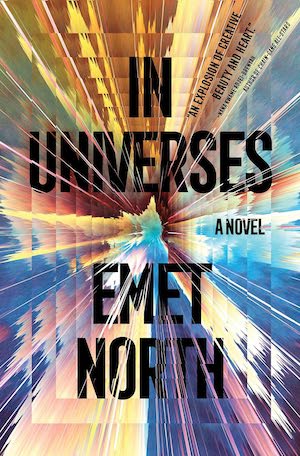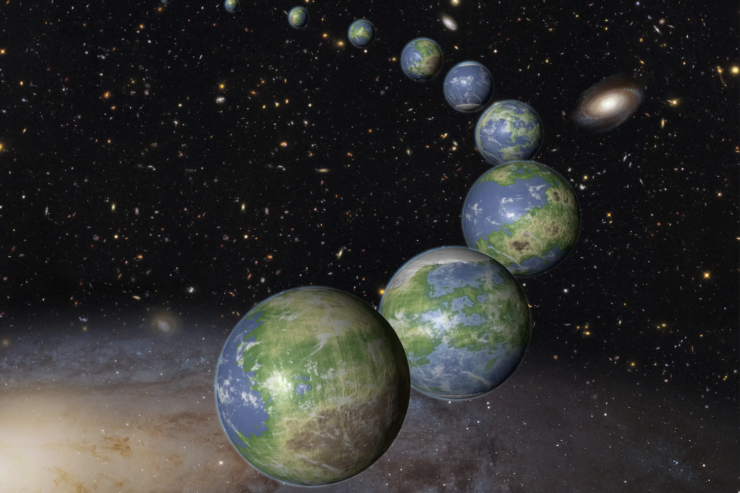Let me begin with a brief thought experiment—a fitting beginning for an essay that is, in part, about theoretical physics. Imagine three possible futures for yourself. Imagine broadly, freely. Let your future selves be bold. Ask yourself where those selves might be in five, ten, fifteen years. How might you change? Who could you become?
There is something strange at the heart of quantum mechanics, the field of physics that focuses on the tiniest parts of the world. The most common distillation of this strangeness is Schrödinger’s cat—a thought experiment once meant to prove that quantum theory must be incomplete or incorrect. Put a cat in a container with a Geiger counter that measures radiation. Inside the Geiger counter is a tiny bit of radioactive material, so tiny that over the course of an hour there’s an equal chance that it decays or doesn’t. If the radioactive material decays, the Geiger counter is triggered and releases a miniature hammer poised above a glass vial of hydrocyanic acid, killing the cat. If the material doesn’t decay, the vial stays intact and the cat stays alive. According to the mathematics of quantum mechanics, until we take a measurement of the radioactive material it exists in a superposition of states. It is both decayed and un-decayed at the same time. Which means that our vial is both shattered and unshattered. Our cat both alive and dead. But upon measurement, this superposition collapses—opening the box, we find that the cat is entirely dead or entirely alive.
To consider an alternate self is to free your imagination from the consequences that weigh on any real decision. It is a way to free your imagination from the vise of plausibility, from the part of the brain that says don’t dream big, don’t get ahead of yourself, don’t, don’t, don’t.
In the hundred or so years since quantum theory was first developed, myriad physicists have attempted to make sense of both what it means for particles to exist simultaneously in mutually exclusive states and why it is that measurement causes these superpositions to collapse. In the 1950s, a PhD student at Princeton, Hugh Everett III, came up with one potential answer in his (somewhat uninspiringly titled) dissertation, Wave Mechanics Without Probability. According to Everett’s formulation, the concept of “collapse” is both unnecessary and misleading. Instead of considering the observer as separate from the quantum system, we ought to consider them as a part of the superposition—which is to say, when we open the box to see whether the cat is alive or dead, we are simultaneously in the state of seeing-alive-cat and seeing-dead-cat. Put another way: we are split into two, mutually exclusive selves. Put yet another way: each time a quantum measurement occurs, the universe branches such that each outcome occurs in a different branch.
In the decades that followed, this interpretation would become what is known as the Many-Worlds Interpretation of quantum mechanics. It is an interpretation that suggests an infinite proliferation of universes. (Not a very economical use of universes, a professor of mine once said.) Is it a viable interpretation? The answer to that question has been debated for decades without resolution. But regardless: who among us has never dreamt of an alternate world? A choice made differently? Who hasn’t stayed up at night, contemplating some difficult decision, wishing it were possible to see both scenarios played out, to know definitively which option to choose. “We can never know what to want,” the Czech writer Milan Kundera wrote, “because, living only one life, we can neither compare it with our previous lives nor perfect it in our lives to come.” The unbearable lightness : “if we have only one life to live, we might as well not have lived at all.” The many worlds interpretation saves us from this lightness, gives our lives the weight of infinite repetition and variation. True, the rescue is more theoretical than practical, given that nothing about the interpretation suggests access to the alternate universes. Which brings us back to our thought experiment.
This time, instead of imagining future selves, imagine three alternate selves. Versions of you who made different choices or were born into different circumstances or who had better luck. Like the last time, follow these selves into the future, see who they might become.
Here is what I want to know: how much distance is there between your imagined futures selves versus your alternate selves? Between what is possible and what is impossible?
When I first began writing my novel, In Universes, I was living in Montana with my boyfriend K, working as a snowboard instructor. I’d tried to become a physicist—I wanted so badly to understand quantum mechanics, the multiverse. I wanted to create thought experiments that changed our understanding of how the world worked on the most fundamental level. But I’d bumped up against the limits of my brain—or maybe against sexism and terrible teaching and depression. Without alternate lives to compare, who can say which? Regardless, I’d left academia and fled to the mountains. For the first time in my life, I stopped trying so hard, built a life that didn’t feel crushing. My relationship with my family had always been fraught, but with K, for the first time, I felt secure in the knowledge that I was loved. I was happy, but not entirely content. I imagined different futures for myself: I could work my way up through the snowboard instructor certification program, spend my days teaching in the snow and sun, come home to write and paint in the evenings. I could work with horses, like I did in the summers. Surround myself with non-human animals, rescue horses from abusive situations and rehab them until they could find new homes. I could go to grad school—for writing or art or the philosophy of physics. (Was the dream dead, or merely deferred?) I never imagined leaving K. Why would I? He was my first and truest home.
Still, none of these imagined futures fully satisfied me. In the evenings, after getting home from the mountain, I switched from writing non-fiction to fiction. I was tired of mining my personal history, I told K. I wanted to look outwards rather than inwards for a while. I read Kelly Link, Abbey Mei Otis, Helen Oyeyemi, Carmen Maria Machado. In their stories, the line between internal and external world became blurred, porous enough that a character’s desires or fears might shape the world—but never in the ways one might expect. Puppets came to life and manipulated their owners, children had to sacrifice parents to protect their homes, a handbag or a tent might offer a doorway to another world. Much like in Everett’s thesis, person and environment became intimately and confusingly entangled. Looking outwards could, in other words, also be a way of looking inwards. I let the worlds of my writing warp and transform: Aliens in the form of golden water turned animals murderous. Girls metamorphosed into insects on their sixteenth birthdays, a mermaid sliced her own tail apart to be with the woman she loved. This, I found, was the constant: my narrators sought—or were sought by—transformation. That and the fact that none of them were in relationships with men. But that was fine. They weren’t me. We might share biographical details, age, gender, overall personality. Innermost hopes and fears. Birthdays, families. But they were in other universes. My life was safe.
What is it that shifts when we move from considering different future selves to alternate selves? Some of it is facts: things become possible that, in our current reality, no longer are. But some of it goes beyond objective difference. To consider an alternate self is to free your imagination from the consequences that weigh on any real decision. It is to avoid the question, yes but at what cost? It is a way to free your imagination from the vise of plausibility, from the part of the brain that says don’t dream big, don’t get ahead of yourself, don’t, don’t, don’t.
Buy the Book


In Universes
Maybe you can guess the ending of this small story of mine. Those fictional selves stayed on the page, in their own universes. But gradually, they expanded my imagination, which is to say, my idea of what might be possible. Queerness opened like a door before me. But I was afraid to walk through. Afraid, above all, of losing K, my family in the truest sense of the word. I couldn’t imagine a way to leave the relationship without losing it. I had no models. So I wrote a universe where the narrator and their partner break up and the breaking isn’t a rupture, only a transformation. I wrote the two of them into a platonic love, one that other people might not understand, but that they understood.
I said goodbye to the mountain, to the lesson line-up and my bright red instructor’s jacket. I devoted myself to writing with my full heart, my full self. I talked to K about my fledgling queerness and he cupped his hands around it, made space for it to grow. We built a new sort of relationship together, no less significant for its changes.
One final piece of the thought experiment, this one particularly for my queer and trans community. Imagine an alternate version of yourself, one that has received all the acceptance and support the world so often denies us. An alternate self whose parents greeted their queerness or transness with joy rather than anger or fear or disgust. A self that didn’t have to hide, who never held the doors to the closet shut for simple self-preservation. A self whose government hasn’t tried to take away their rights, their access to care. Who hasn’t had their body politicized and made a talking point for self-righteous politicians. Here’s what I want to know now: How would that version of you move through the world? What possibilities are open to them?
And finally, can you queer the universe a little? Reach through and borrow whatever it is you need—confidence, safety, love? Those alternate selves, they won’t mind sharing. They have enough to go around.










